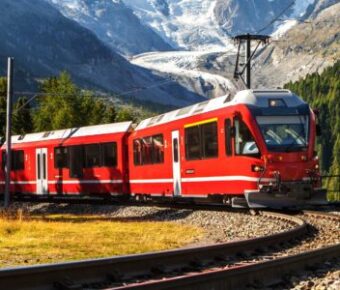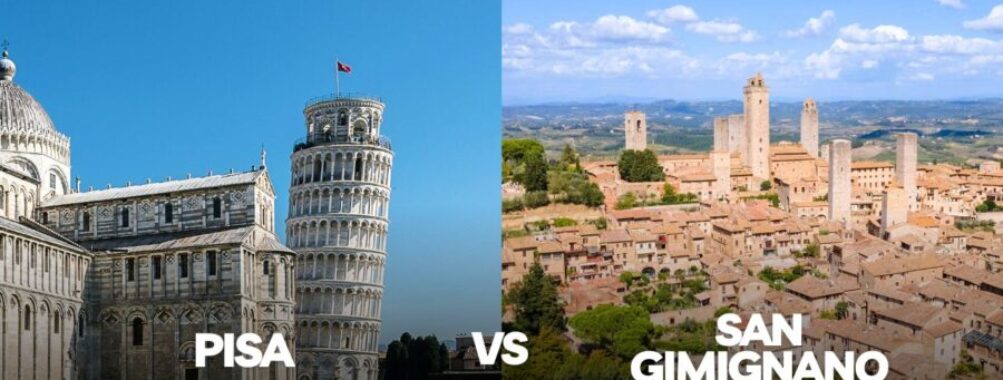
Pisa vs San Gimignano: Which Stunning Tuscan City Should You Visit First?
Planning a trip to Tuscany means choosing between incredible destinations, and two gems stand out: Pisa and San Gimignano. These towns offer entirely different experiences of Italian life and culture.
Pisa draws millions to see its famous leaning tower and grand cathedral, while San Gimignano captivates visitors with its medieval towers and intimate atmosphere that feels frozen in time. The contrast between these destinations creates a tough choice for travelers with limited time in Tuscany.
Both towns sit within easy reach of Florence, making them perfect day trip options. Pisa buzzes with student life and modern energy around its historic center, while San Gimignano’s narrow lanes and preserved architecture transport visitors to the 13th century. Its hilltop location offers stunning views across the Tuscan countryside that Pisa’s flat terrain can’t match.
Contents
- Getting There
- Accessing Pisa
- Discovering San Gimignano
- Historical Insights
- Pisa’s Rich Heritage
- Medieval Charm of San Gimignano
- Cultural Experience
- Pisan Life
- San Gimignano’s Atmosphere
- Architectural Marvels
- Pisa’s Architectural Wonders
- Towers of San Gimignano
- Culinary Delights
- Tastes of Pisa
- San Gimignano’s Culinary Scene
- Leisure Activities
- Exploring Around Pisa
- Adventures in San Gimignano
- Accommodation Guide
- Staying in Pisa
- Lodging in San Gimignano
- Excursions and Day Trips
- Pisa’s Surroundings
- San Gimignano Side Trips
- Practical Tips
- Frequently Asked Questions
- What are the top tourist attractions in San Gimignano for a day trip?
- Can you compare the travel experiences between Pisa and San Gimignano?
- What is the ideal amount of time to allocate to visit Pisa?
- How can one travel from Pisa to San Gimignano, and what are the transportation options?
- What unique experiences does San Gimignano offer that differ from those in Pisa?
- Are there hidden gems in Pisa or San Gimignano that are away from the usual tourist trail?
- More Travel Guides
Getting There
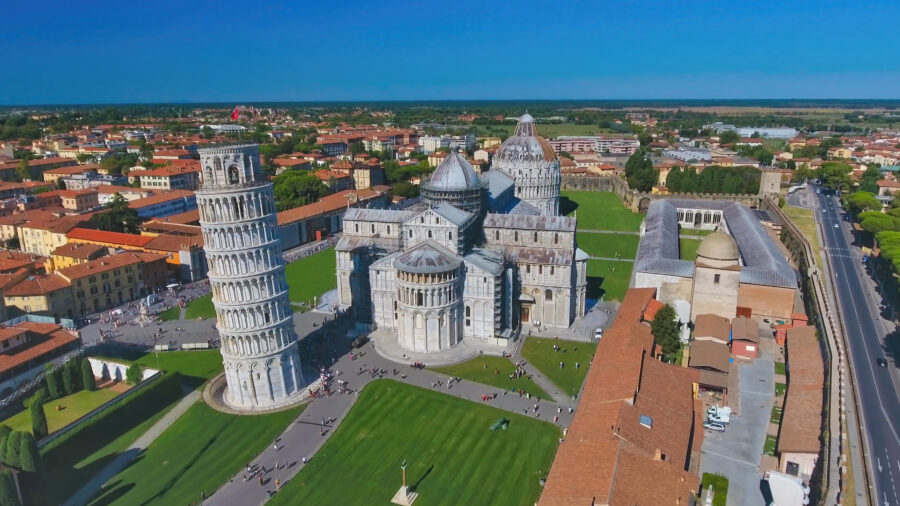
Both cities offer distinct transportation options that make them accessible from major Tuscan hubs. Train routes and rental cars give travelers flexibility in reaching these destinations.
Accessing Pisa

Pisa sits on the main rail lines connecting it to Florence, Rome, and other Italian cities. Trains arrive at Pisa Centrale station, located just 20 minutes on foot from the famous Leaning Tower. Direct trains from Florence take about an hour.
The city has its airport, Galileo Galilei International, which welcomes flights across Europe. An automated shuttle connects the airport to Pisa Centrale in just 5 minutes.
Local buses run frequently between the train station and the main attractions. Walking remains popular since the historic center is compact and flat.
Discovering San Gimignano

San Gimignano requires more planning to reach. The nearest train station is in Poggibonsi, about 7 miles away. Regular buses connect Poggibonsi to San Gimignano in 20 minutes.
Many visitors search for flights and rental cars since driving offers the most direct route. The roads wind through beautiful Tuscan countryside.
Buses run several times daily from Florence and Siena. The trip takes 1-1.5 hours, depending on the route and traffic. Bus tickets can be bought at stations or from drivers.
Historical Insights

Both cities showcase distinct chapters of Tuscan history through architecture and cultural legacies. Pisa rose to maritime glory while San Gimignano became a wealthy medieval trading post.
Pisa’s Rich Heritage
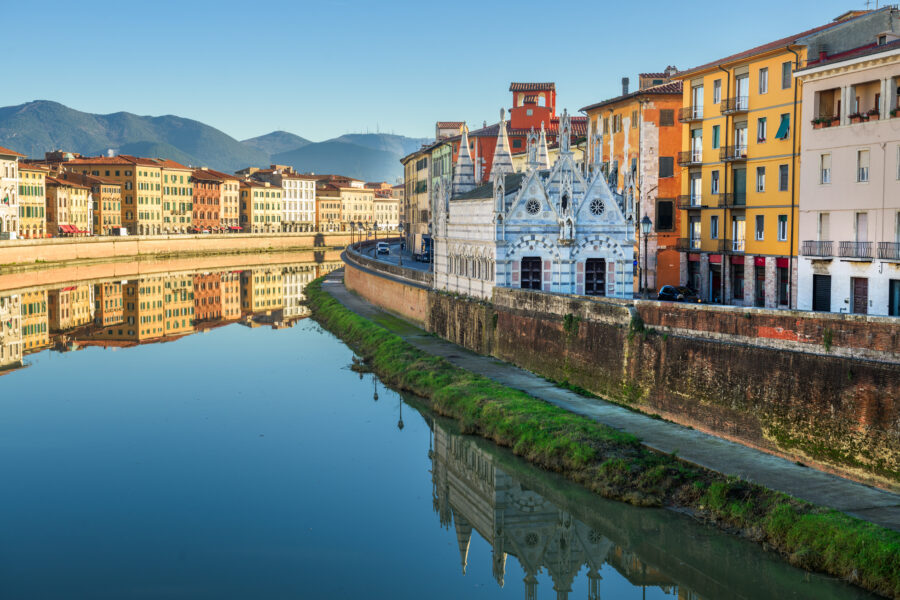
Pisa stands as a testament to maritime power and artistic achievement. The city peaked during the 11th and 12th centuries as a major Mediterranean naval force.
The famous Leaning Tower was constructed in 1173 and took nearly 200 years. Its tilt began during construction due to soft ground on one side—a happy accident that made it world-famous.
The Piazza del Duomo contains four masterpieces of medieval architecture: the cathedral, baptistery, campanile (Leaning Tower), and cemetery. These white marble buildings show Pisa’s wealth and artistic vision.
Medieval Charm of San Gimignano

San Gimignano’s skyline tells the story of competing merchant families. In the 1300s, 72 tower houses stretched toward the sky, each built taller than the last to show off family wealth and power.
The town faced tragedy when the Black Death struck in 1348, wiping out 60% of its population. This devastating event marked the end of San Gimignano’s golden age.
Today, 13 original towers remain. The tallest, Torre Grossa, reaches 177 feet high. The preserved medieval architecture earned San Gimignano recognition as a UNESCO World Heritage site.
The town sits 334 meters above the Elsa Valley on land first settled by Etruscans in the 3rd century BC. Its strategic hilltop location helped protect trade routes between Siena and Florence.
Cultural Experience

Pisa and San Gimignano offer two distinct views into Tuscan life. One shows a bustling university scene, while the other reveals a slower-paced medieval charm that captures hearts.
Pisan Life
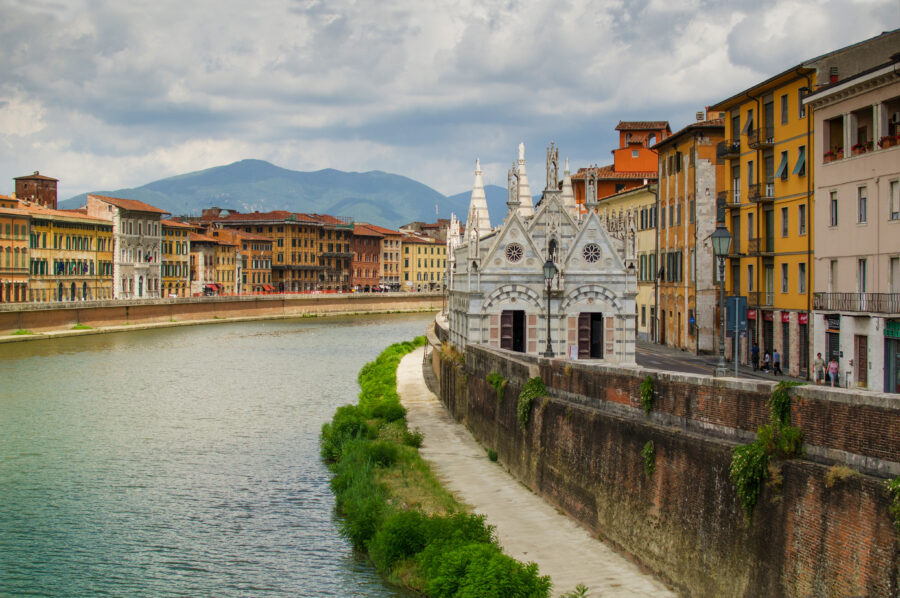
Pisa’s streets buzz with student energy thanks to its famous university. Young people fill the cafes and shops, creating a lively mix of old and new culture.
The city keeps its traditions alive through festivals like the Luminara, when thousands of candles light up the buildings along the Arno River—local markets buzz with vendors selling fresh produce and regional specialties.
Street musicians play near the university, and art galleries showcase classic and modern works. In narrow alleys, Authentic Tuscan restaurants are located, where locals gather for long lunches.
San Gimignano’s Atmosphere
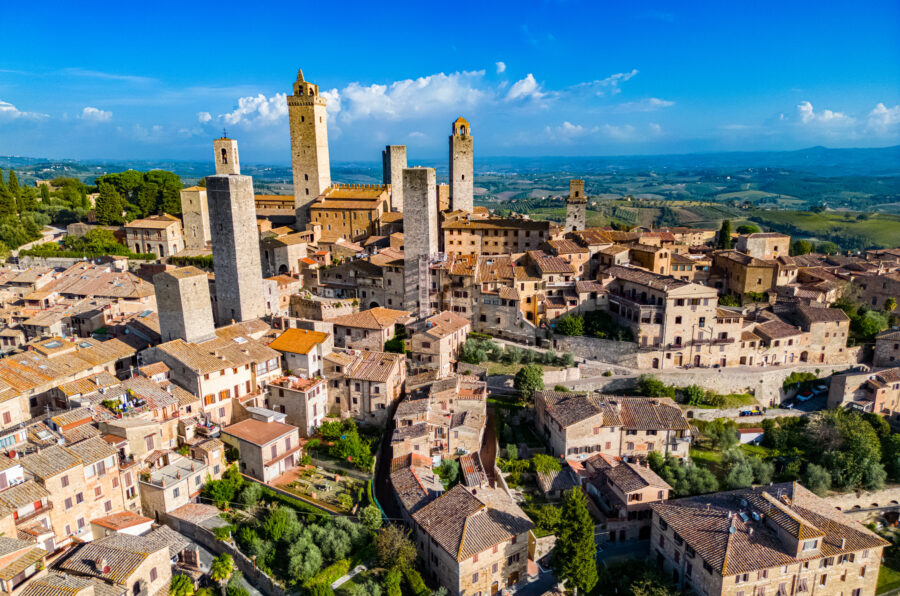
San Gimignano feels like stepping into a medieval storybook. Its famous towers rise above cobblestone streets where artisans work in small shops making traditional crafts.
The town’s famous gelato shops serve unique flavors made from local ingredients. World champion gelato makers create treats that draw visitors from across Italy.
Life moves at a gentler pace here. Locals chat in the main square, Piazza della Cisterna, while sipping coffee or enjoying evening walks called passeggiata.
The surrounding vineyards and olive groves create a peaceful backdrop. Artists set up easels in quiet corners to capture the town’s timeless beauty and rolling Tuscan hills.
See Related: Florence vs Pisa: Which Historic Tuscan City Offers the Better Italian Experience?
Architectural Marvels

These two Tuscan towns showcase Italy’s most breathtaking medieval architecture through their distinct styles. Pisa’s gleaming marble monuments starkly contrast with San Gimignano’s striking tower-filled skyline.
Pisa’s Architectural Wonders
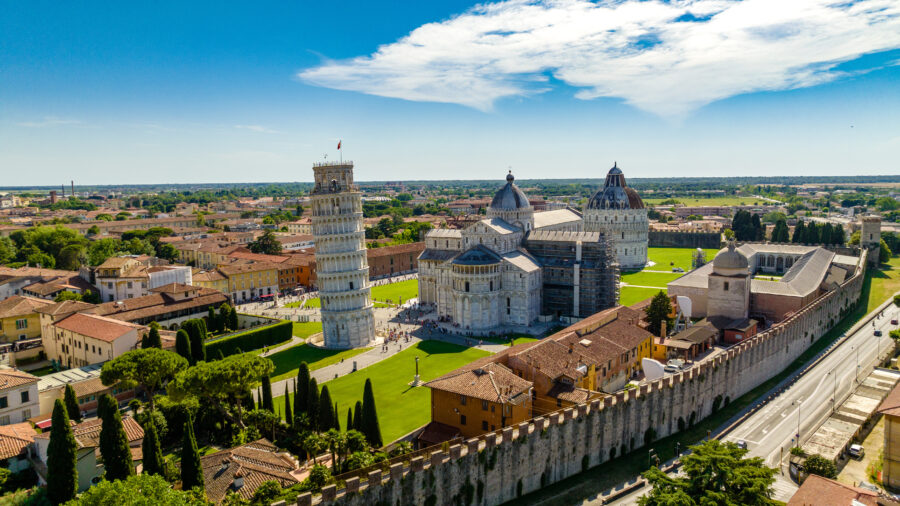
The Piazza del Duomo contains Pisa’s most famous architectural gems. The iconic Leaning Tower, with its unstable foundation, tilts at a 3.9-degree angle, making it one of the world’s most unique structures.
The white marble monuments around the square create a stunning visual display. The Pisa Cathedral showcases elegant Romanesque architecture with its intricate columns and arches.
The Baptistery is Europe’s largest, featuring Gothic and Romanesque designs. Its perfect acoustics allow for impressive musical demonstrations, with notes echoing for several seconds.
Towers of San Gimignano

San Gimignano’s medieval skyline earned it the nickname “Medieval Manhattan.” While 72 towers once dominated the town, 14 remain symbols of wealth and power from medieval noble families today.
The Torre Grossa is the tallest surviving tower, reaching 54 meters high. Visitors can climb to the top for amazing views of the Tuscan countryside.
The towers vary in height and design, creating a unique silhouette visible for miles. Each tower tells its story of the competing families who built ever-taller structures to display their status.
The preserved medieval architecture makes you feel transported back in time. Cars and modern buildings stay outside the town walls, maintaining its authentic historic atmosphere.
Culinary Delights
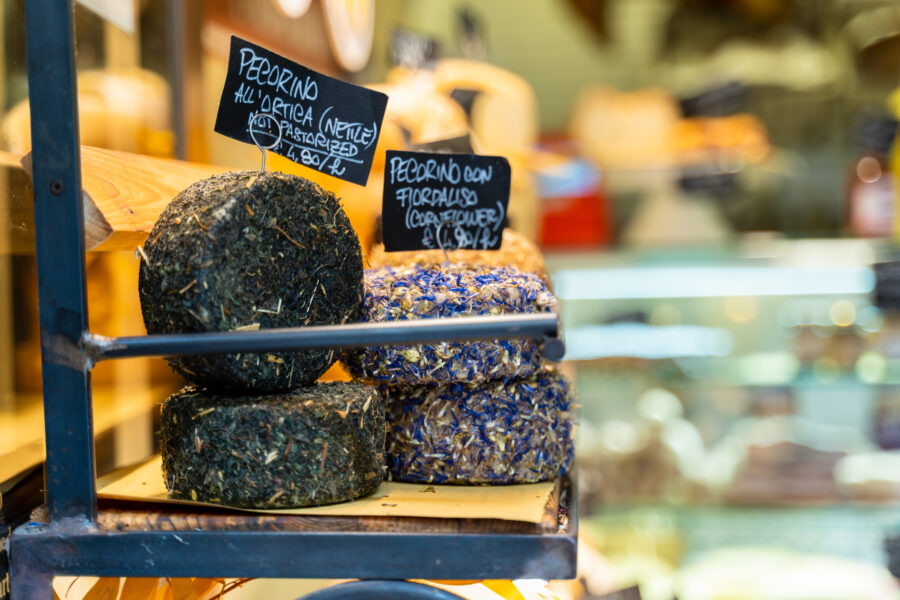
Both cities serve amazing Tuscan flavors, with Pisa offering traditional trattorias and San Gimignano featuring world-famous wines and local specialties.
Tastes of Pisa
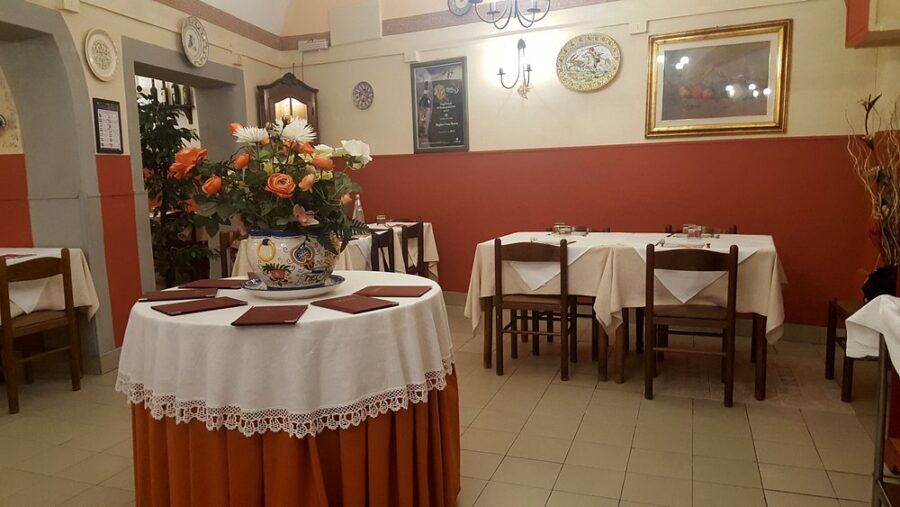
Pisa’s food scene goes way beyond tourist spots near the Leaning Tower. Hidden gems like Trattoria da Mario serve perfect ribollita soup and fresh pasta with wild boar sauce. The local markets burst with colors and aromas – Sant’Antonio Market is ideal for picking up Pecorino cheese and Tuscan olive oil.
Want amazing gelato? Stop by De’ Coltelli near the Arno River. They make creative flavors using local ingredients like Tuscan pine nuts and seasonal fruits.
The streets around Via Santa Maria hide cozy wine bars serving regional Chianti. These spots pair fantastic wines with crostini topped with fresh tomatoes and basil.
San Gimignano’s Culinary Scene
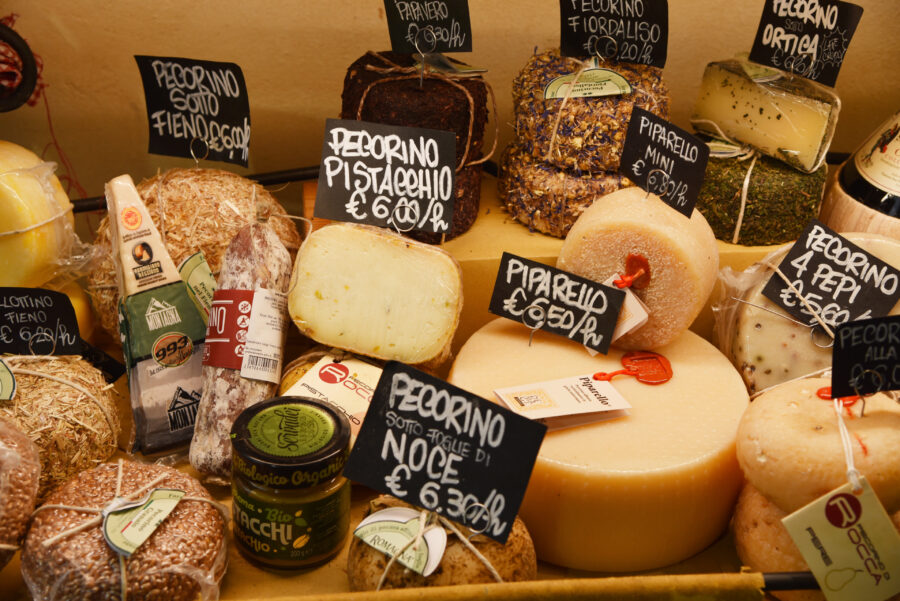
San Gimignano shines with its award-winning white wine, Vernaccia di San Gimignano. Local vineyards like Tenuta Torciano offer tastings with stunning views of the medieval towers.
The town is famous for its world-champion gelato at Gelateria Dondoli. Try its unique saffron flavor, which uses local spices grown in the surrounding hills.
Small family-run spots like Cum Quibus serve up traditional Tuscan dishes. Don’t miss their handmade pici pasta with black truffle sauce.
The weekly farmers’ market in Piazza delle Erbe showcases local specialties. You’ll find fresh porchetta, aged cheeses, and seasonal vegetables from nearby farms.
Leisure Activities
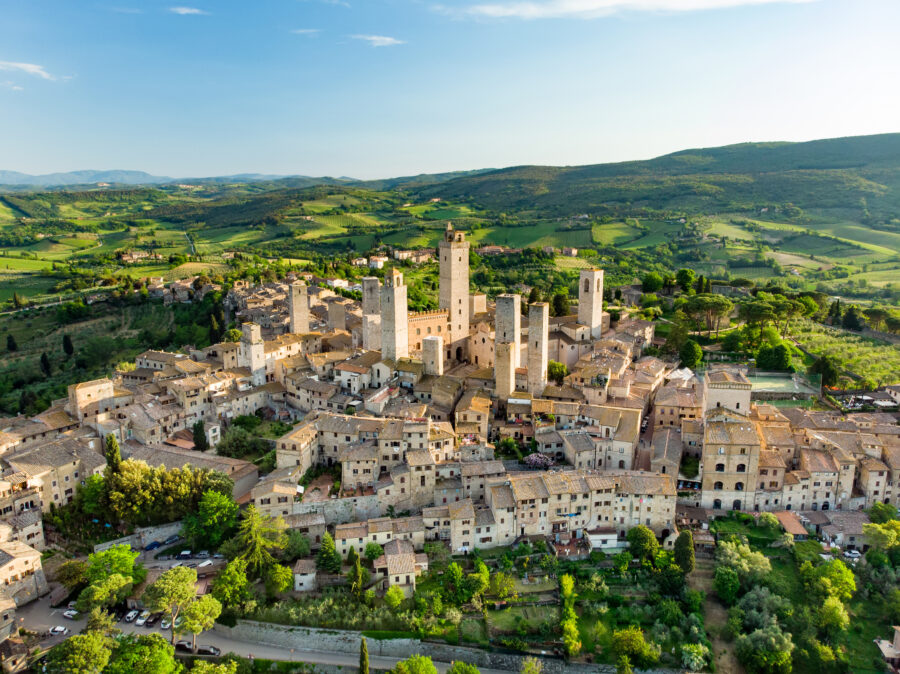
Pisa and San Gimignano offer unique ways to spend your free time, from beach trips to wine tasting among rolling hills.
Exploring Around Pisa
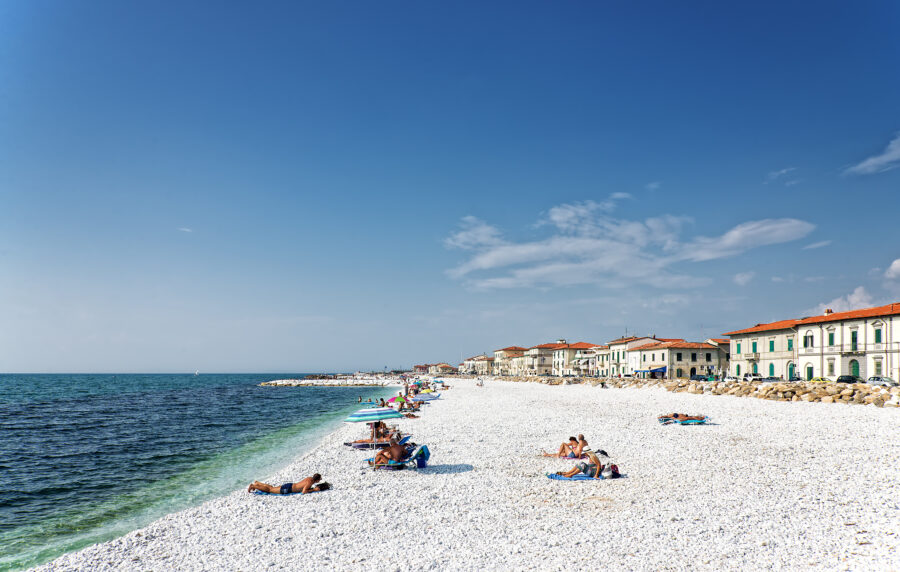
Beach lovers can take a quick 20-minute train ride to Marina di Pisa for a relaxing day by the sea. The beach stretches for miles and has colorful umbrellas and charming seafood restaurants.
Want a break from sightseeing? Grab a gelato and people-watch at one of the many outdoor cafes along Borgo Stretto, Pisa’s main shopping street. The atmosphere is lively, with street musicians often performing nearby.
Pisa makes an excellent base for day trips. The famous Cinque Terre villages are just 1.5 hours away by train. These five colorful towns perched above the Mediterranean offer stunning coastal walks and fantastic seafood.
Adventures in San Gimignano
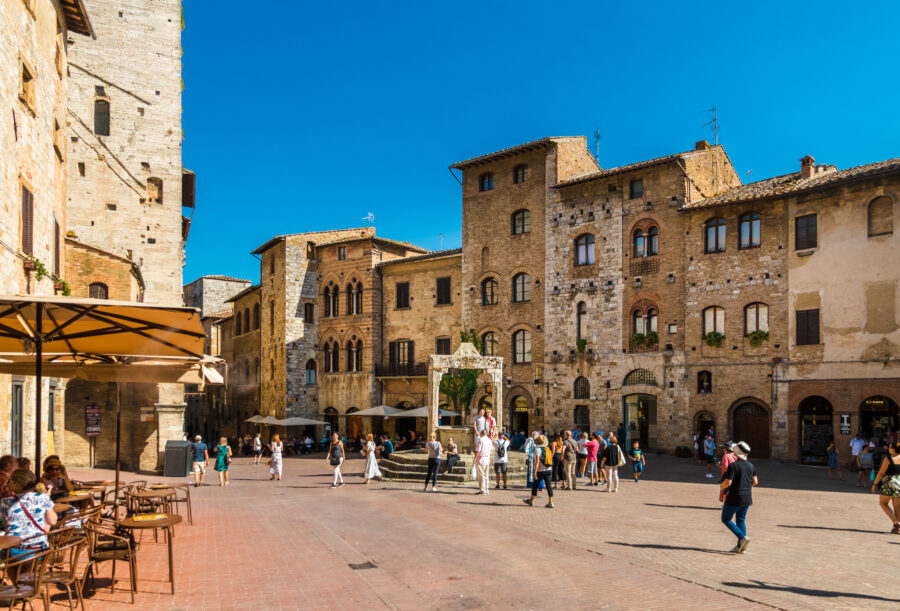
San Gimignano sits right in prime wine country. Local vineyards welcome visitors for tastings of their famous Vernaccia white wine. Many offer tours where you can walk through the vines and learn about wine-making.
The hills around town have well-marked hiking trails. A popular 2-hour loop starts at Porta San Giovanni and winds through olive groves and cypress trees. The views of San Gimignano’s towers from the trail are amazing.
The town’s main square, Piazza della Cisterna, comes alive in warm weather. Grab a seat at an outdoor cafe to taste the world-famous gelato while watching medieval flag-throwing shows.
See Related: 10 Day Italy Trip Cost: Budget Your Dream Vacation
Accommodation Guide
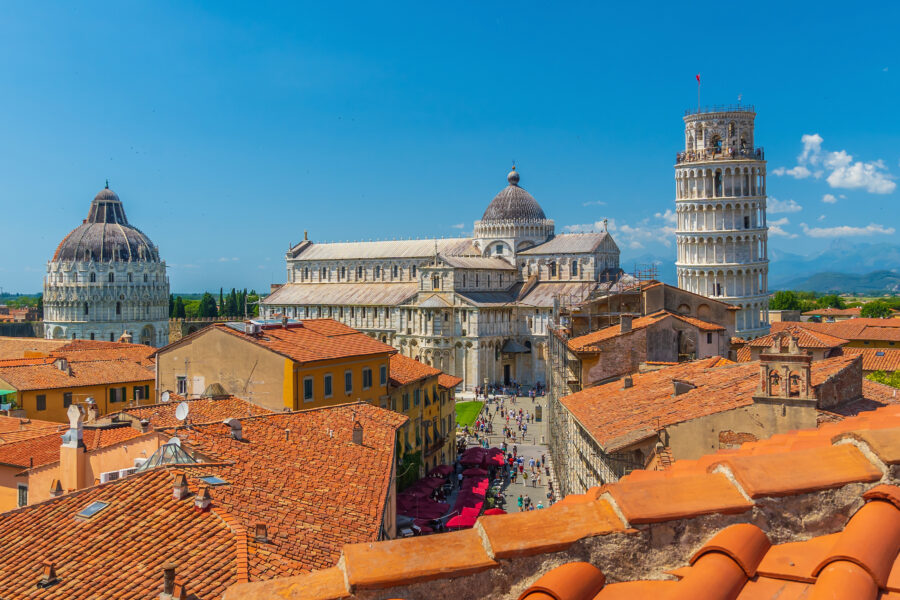
Both cities offer distinct lodging experiences – Pisa provides modern hotels near major attractions, while San Gimignano specializes in charming historic properties within medieval walls.
Staying in Pisa

Most visitors choose to stay near the Leaning Tower in the historic center. Booking.com lists many mid-range hotels in this area, with prices ranging from €80 to € 150 per night.
The train station neighborhood offers more budget-friendly options. Tourists can find simple but clean rooms for €50-70 nightly. This location makes day trips to Lucca very easy.
Some luxury hotels occupy restored palaces along the Arno River. These properties feature original frescoes and antique furnishings, with rates starting at €200.
Lodging in San Gimignano
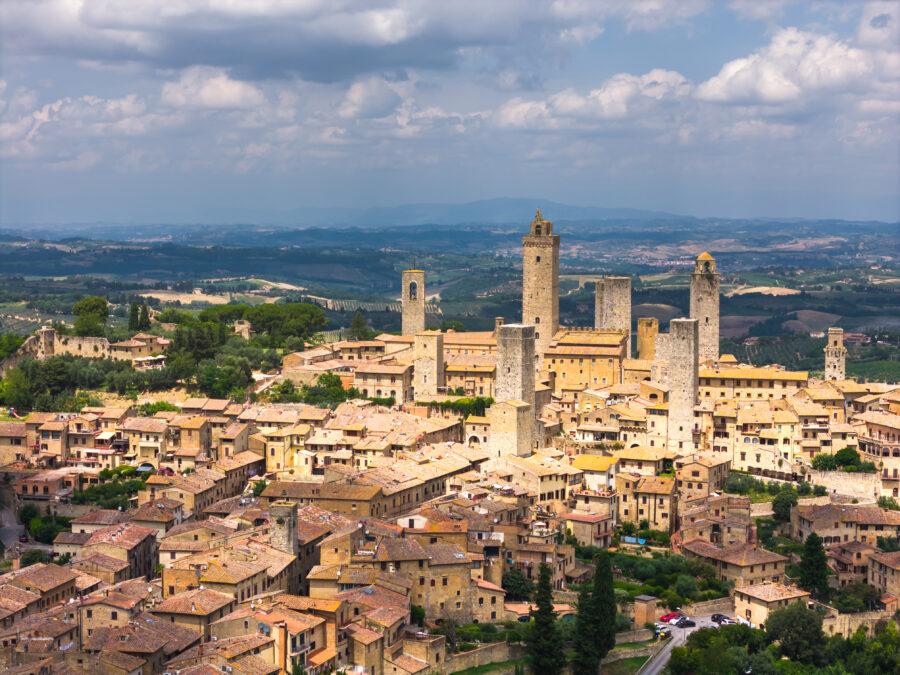
The medieval town center contains converted historic buildings that are now boutique hotels. Most have stone walls, wooden beams, and fantastic tower views.
Small family-run properties dominate the scene. Many include home-cooked Tuscan breakfasts and insider tips from local owners. Rates typically run €120-180 per night.
Several agriturismo farms dot the surrounding countryside. These rural properties let guests experience authentic Tuscan life while close to town. Features often include pools, cooking classes, and wine tastings.
Space fills quickly during peak season from May to October. Booking at least 3-4 months ahead is smart, especially for prime locations within the walls.
Excursions and Day Trips
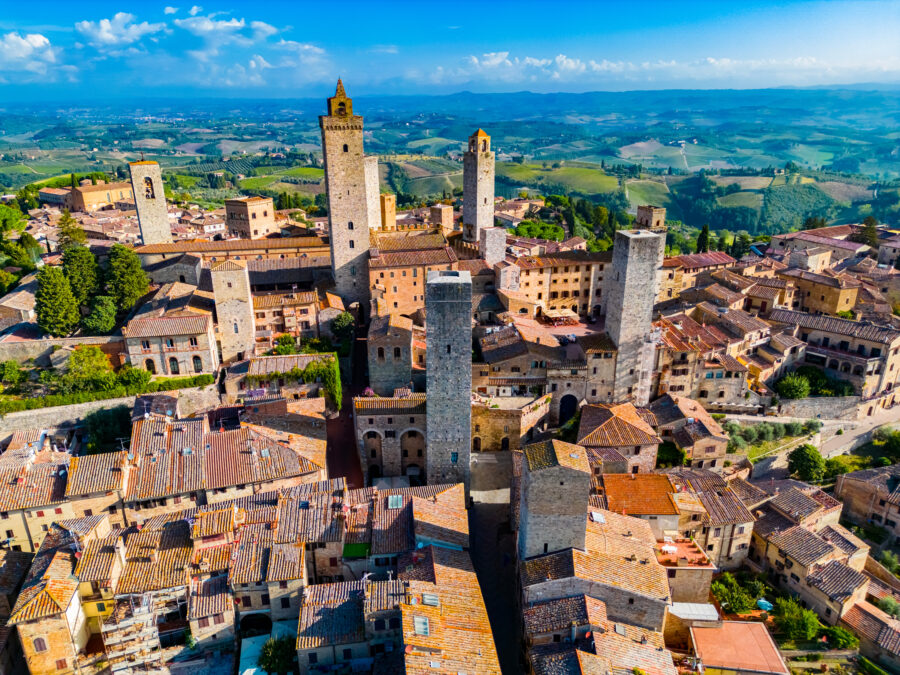
Both Pisa and San Gimignano are excellent starting points for exploring the treasures of Tuscany. Each city offers unique opportunities to visit nearby medieval towns, rolling countryside, and historic landmarks.
Pisa’s Surroundings
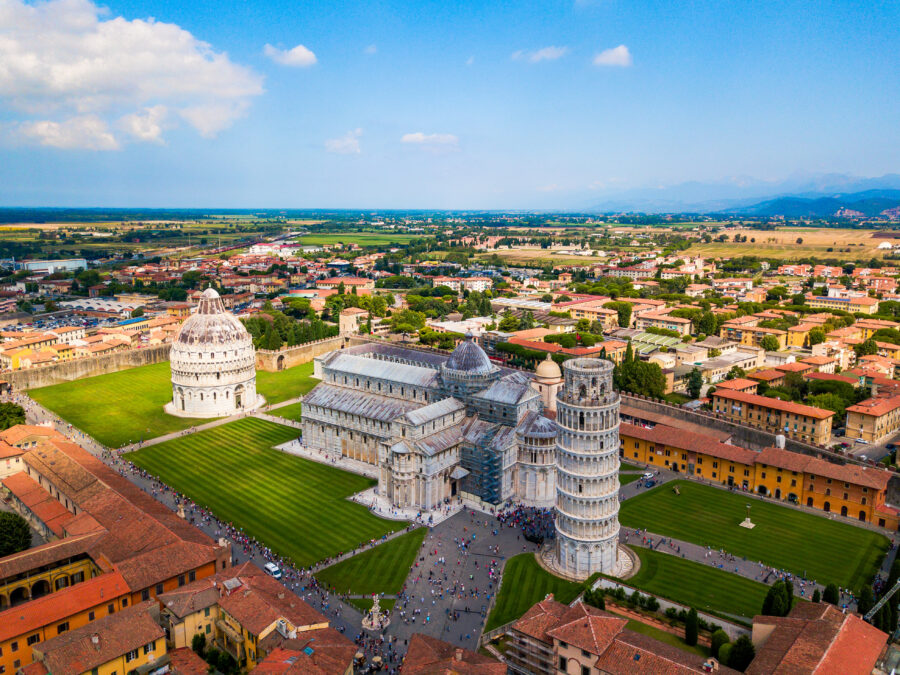
Pisa makes an excellent base for visiting nearby cities. You can take quick trips to Lucca, just 30 minutes away by train, to bike along its famous Renaissance walls. The coastal town of Livorno sits 20 minutes from Pisa, perfect for seafood lovers and beach visits.
Many travelers join guided tours to Florence for a day of art and culture. The trip takes about an hour by train.
Bologna is another good day trip choice. The food-loving city is two hours from Pisa by train.
San Gimignano Side Trips

San Gimignano’s central location makes several must-see Tuscan destinations easily accessible. With its stunning cathedral and famous Piazza del Campo, Siena is just 45 minutes away by car or bus.
The ancient Etruscan town of Volterra is 30 minutes away. Its Roman ruins and alabaster workshops attract fewer tourists than other Tuscan towns.
Wine tasting tours through the Chianti region run daily from San Gimignano. These trips include stops at vineyards and medieval villages.
The trip to Florence takes about an hour. Many visitors combine San Gimignano and Florence in a single day of sightseeing.
Practical Tips

Getting to Pisa is simple by train from Florence, with frequent daily connections taking about an hour. San Gimignano requires a bus ride since it lacks a train station.
The best time to visit Pisa’s Leaning Tower is early morning or late afternoon to avoid peak crowds. Book tower climb tickets online at least 2-3 days ahead during busy seasons.
San Gimignano gets packed with tour groups between 11 a.m. and 4 p.m. For a more peaceful experience exploring the medieval towers and streets, plan to arrive before 10 a.m. or after 4 p.m.
Dining tips:
- Pisa: Most restaurants near the Tower are tourist traps. Walk 10-15 minutes to the local areas
- San Gimignano: Try the famous gelato at Gelateria Dondoli in Piazza della Cisterna
- Both towns have great local wine bars serving Tuscan varieties
Pack comfortable walking shoes. Both towns have steep hills and uneven cobblestone streets that can be tough on feet.
Consider visiting both towns separately rather than rushing through both in one day. This gives enough time to explore beyond just the main tourist spots.
Parking can be tricky in both places. Use official lots outside the town centers, which are marked and offer shuttle services to the main attractions.
Want stunning photos? The best view of San Gimignano’s towers is from Podere la Marronaia vineyard. In Pisa, head to Palazzo dei Cavalieri for a unique angle of the Leaning Tower.
See Related: Siena vs San Gimignano: Which Enchanting Tuscan Town Should You Visit First?
Frequently Asked Questions
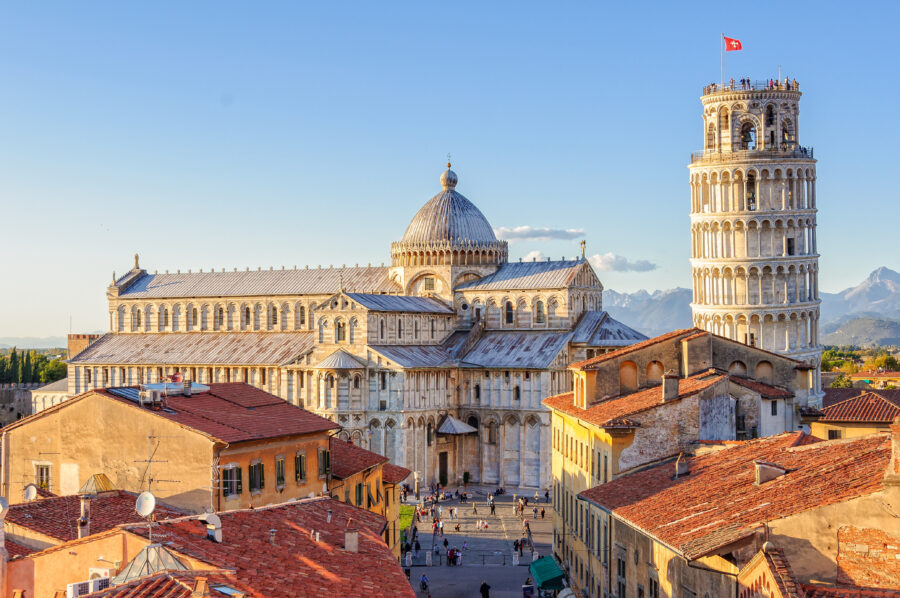
Exploring Pisa and San Gimignano brings unique experiences in two distinct Tuscan settings. Each town offers special cultural treasures and memorable moments that make it worth visiting.
What are the top tourist attractions in San Gimignano for a day trip?
The medieval towers stand as San Gimignano’s most striking feature. Visitors can climb Torre Grossa, the tallest tower, for amazing views of the Tuscan countryside.
Piazza della Cisterna is a perfect spot for people-watching and gelato tasting.
The square’s old well and medieval buildings transport visitors back in time.
The Collegiate Church amazes guests with its beautiful frescoes. Art lovers spend hours studying the detailed Biblical scenes on the walls.
Can you compare the travel experiences between Pisa and San Gimignano?
Pisa offers a grand, bustling city atmosphere with its famous Leaning Tower and Piazza dei Miracoli. The streets buzz with university students and tourists mixing.
San Gimignano gives visitors a quieter, medieval hill town experience.
Its narrow cobblestone streets and stone buildings create a more intimate feel.
The crowds differ too. Pisa gets packed with daytrippers rushing to see the tower, while San Gimignano feels more relaxed, especially in the early morning or evening.
What is the ideal amount of time to allocate to visit Pisa?
Most visitors need 3-4 hours to see Pisa’s main attractions. This gives enough time to explore the Leaning Tower, the Cathedral, and the Baptistery.
A full day lets people discover more of the city. They can walk along the Arno River, visit the Botanical Garden, and enjoy local restaurants.
How can one travel from Pisa to San Gimignano, and what are the transportation options?
The train connects Pisa to Poggibonsi, followed by a bus ride to San Gimignano. The journey takes about 2 hours total.
Renting a car gives more freedom and takes around 1.5 hours—the drive winds through pretty Tuscan landscapes.
What unique experiences does San Gimignano offer that differ from those in Pisa?
San Gimignano specializes in Vernaccia wine production. Local wine shops offer tastings of this crisp white wine unique to the region.
The town’s famous gelato shops compete for the title of “world’s best gelato.” Visitors can sample unusual flavors like saffron or pink peppercorn.
Walking the ancient city walls provides stunning views of vineyards and olive groves. These peaceful spots feel worlds away from busy tourist areas.
In Pisa, the Santa Maria della Spina church sits quietly by the Arno River. This tiny Gothic church holds beautiful sculptures and gets few visitors.
San Gimignano’s Sant’Agostino Church contains impressive frescoes. Most tourists miss this artistic treasure while focused on the main square.
The back streets of both towns hide small family restaurants. These spots serve authentic Tuscan dishes at better prices than tourist areas.



